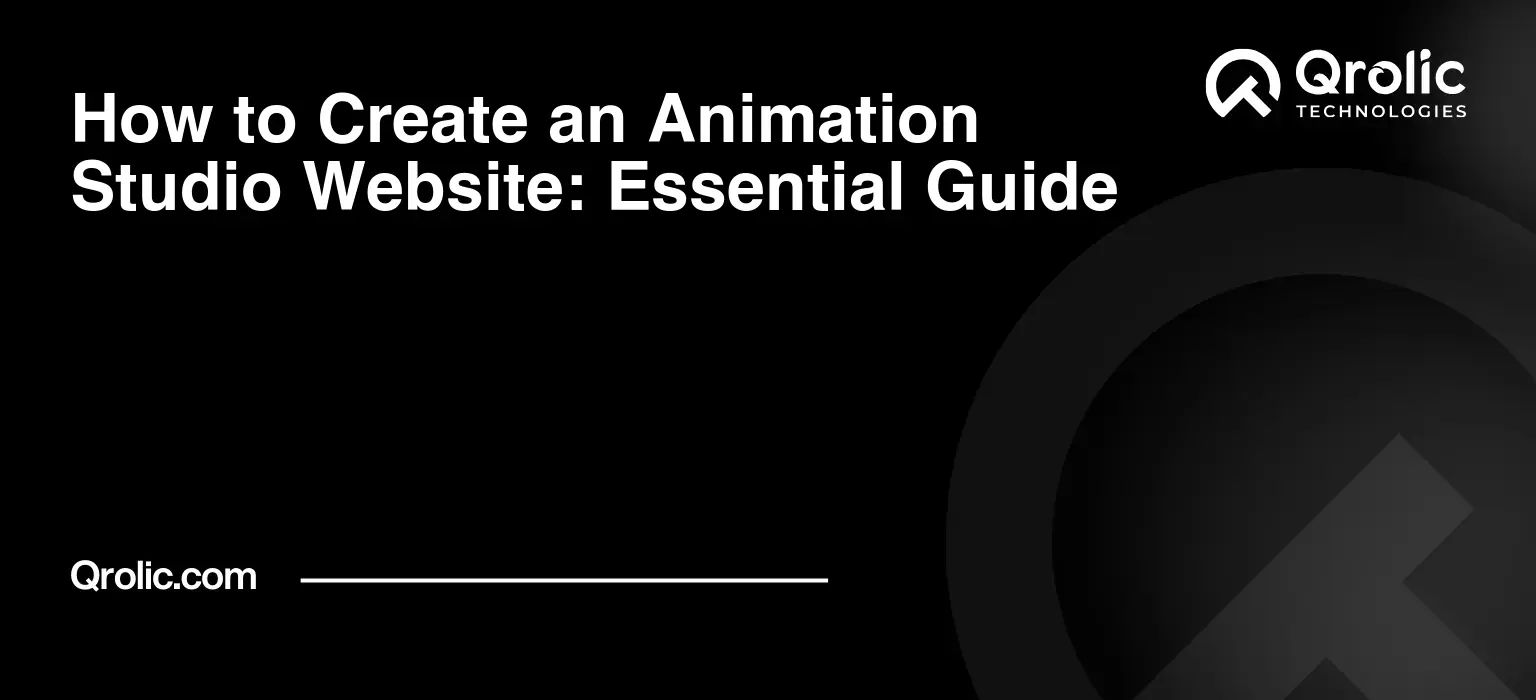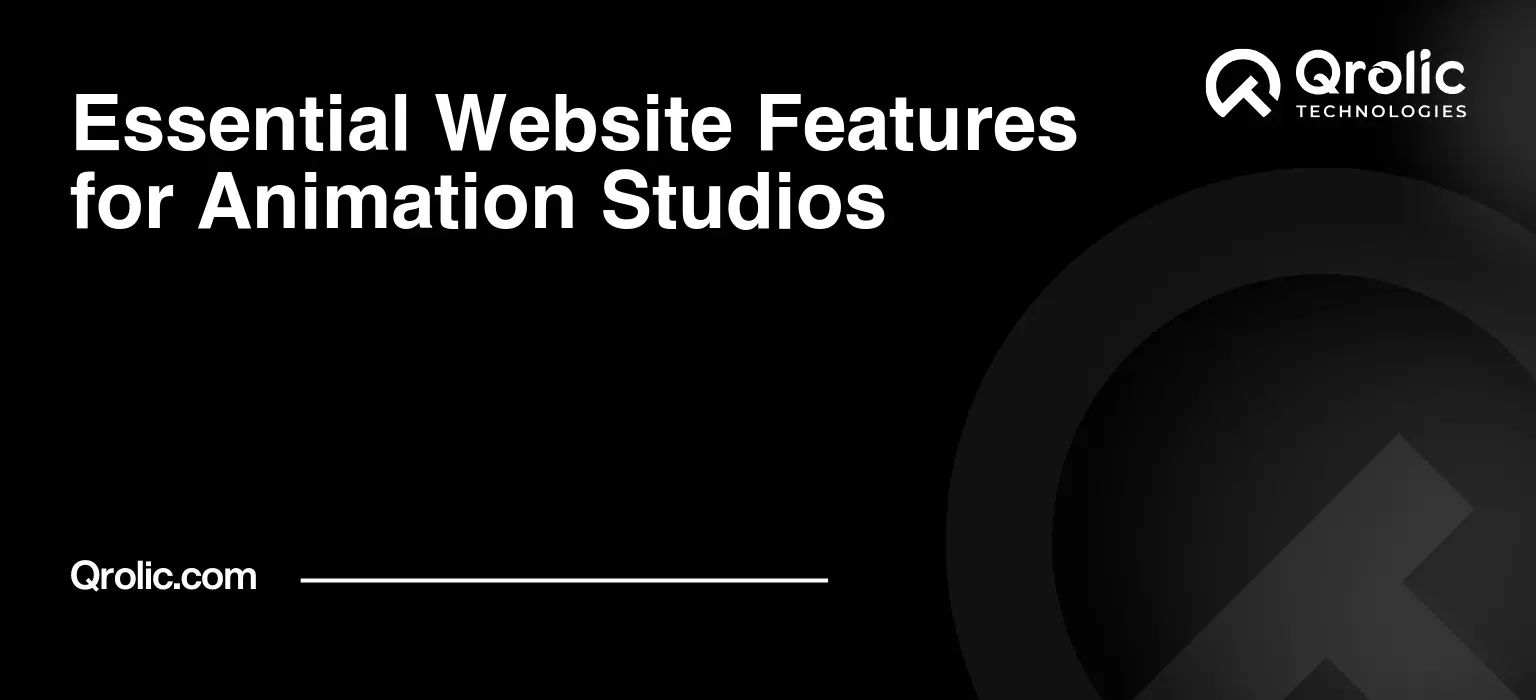Quick Summary:
- Your website is vital to showcase animation work.
- Define your target audience and studio niche first.
- Design a visual site with key pages and SEO.
- Promote your website and continuously improve it.
Table of Contents
- Understanding the “Why” Behind Your Animation Studio Website
- The Power of First Impressions: Showcasing Your Animation Prowess
- Beyond the Showcase: Website Functionality and Purpose
- Defining Your Target Audience and Niche: The Key to Success
- Identifying Your Ideal Client: Buyer Personas
- Finding Your Niche: Standing Out in a Crowded Market
- Planning Your Website Structure and Content: A Blueprint for Success
- Essential Website Pages: The Foundation of Your Online Presence
- Content Strategy: Crafting Compelling and Engaging Content
- Choosing the Right Platform and Design: Building Your Digital Home
- Website Platforms: CMS vs. Custom Development
- Website Design: Creating a Visually Stunning Experience
- Essential Design Elements for Animation Studio Websites:
- SEO Optimization: Getting Your Website Seen
- Keyword Research: Finding the Right Terms
- On-Page Optimization: Making Your Website Search Engine Friendly
- Off-Page Optimization: Building Your Website’s Authority
- Technical SEO: Ensuring Your Website is Crawlable
- Promoting Your Website: Getting the Word Out
- Social Media Marketing: Engaging Your Audience
- Email Marketing: Nurturing Leads and Building Relationships
- Content Marketing: Providing Value and Building Authority
- Paid Advertising: Reaching a Wider Audience
- Analyzing and Improving: Continuous Optimization
- Website Analytics: Tracking Your Progress
- Identifying Areas for Improvement:
- Implementing Changes and Monitoring Results:
- Qrolic Technologies: Your Partner in Digital Success
- How Qrolic Technologies Can Help Your Animation Studio:
- Final Thoughts: Your Animation Studio Website is an Investment
Understanding the “Why” Behind Your Animation Studio Website
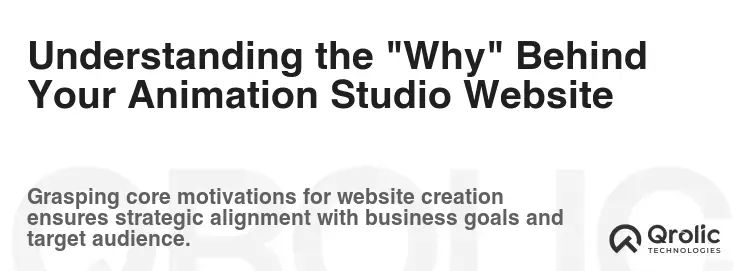
Why bother with a website at all? In today’s digital age, an animation studio website isn’t just a luxury; it’s an absolute necessity. Think of it as your digital storefront, open 24/7, showcasing your talents to the entire world.
The Power of First Impressions: Showcasing Your Animation Prowess
- Building Credibility: A well-designed website immediately establishes credibility. Potential clients will take you more seriously if they see a polished, professional online presence. It’s a statement that you’re invested in your business and dedicated to delivering quality work.
- Visual Storytelling: Your website is your biggest canvas. Use it to tell your story. Show your best work, highlight your unique style, and let visitors experience the magic of your animation. Don’t just tell them you’re good; show them!
- Attracting the Right Clients: A targeted website acts like a magnet, attracting the clients you want. By clearly defining your niche, showcasing relevant projects, and using the right keywords, you can filter out projects that aren’t a good fit and focus on the ones that are.
Beyond the Showcase: Website Functionality and Purpose
- Lead Generation: Your website is a lead generation machine. Include clear calls to action (CTAs) like “Get a Quote,” “Contact Us,” or “Download Our Portfolio” to capture visitor information and turn them into potential clients.
- Client Education: Explain your process, your services, and your pricing in detail. An informed client is a happy client. Transparency builds trust and reduces friction in the sales process.
- Brand Building: Your website is the central hub for your brand. Use it to communicate your values, your personality, and your mission. Consistency in branding across your website, social media, and other marketing materials will solidify your brand identity.
- SEO and Discoverability: A properly optimized website is crucial for search engine visibility. When potential clients search for “animation studio near me” or “explainer video services,” you want your website to be at the top of the results.
Defining Your Target Audience and Niche: The Key to Success

Before you even start thinking about design and content, you need to understand who you’re trying to reach. Who are your ideal clients? What are their needs and pain points? What kind of animation projects are they looking for?
Identifying Your Ideal Client: Buyer Personas
- Industry Focus: Are you specializing in animation for the gaming industry, advertising, education, or something else entirely?
- Project Size: Are you targeting large corporations with big budgets or small businesses looking for affordable solutions?
- Specific Needs: What specific types of animation are they looking for? 2D animation, 3D animation, motion graphics, stop-motion, explainer videos, character design, etc.?
- Budget Expectations: Understanding their budget expectations will help you tailor your pricing and service offerings.
- Decision-Making Process: Who are the key decision-makers? What influences their decisions?
Creating detailed buyer personas will help you create a website that speaks directly to your target audience and addresses their specific needs.
Finding Your Niche: Standing Out in a Crowded Market
The animation industry is competitive. Finding a niche can help you differentiate yourself and attract a specific type of client.
- Industry Specialization: Focus on a particular industry, such as healthcare, finance, or technology.
- Animation Style: Specialize in a specific animation style, such as 2D character animation, 3D product visualization, or motion graphics for social media.
- Service Offering: Offer a unique service, such as animated explainer videos for startups or animated marketing campaigns for e-commerce businesses.
By focusing on a niche, you can become the go-to expert in that area and attract clients who are specifically looking for your expertise.
Planning Your Website Structure and Content: A Blueprint for Success
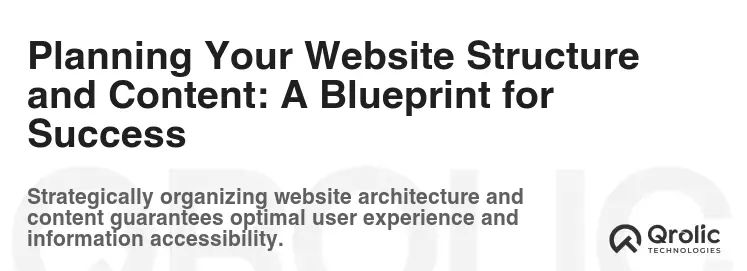
Once you know your target audience and niche, you can start planning your website’s structure and content. A well-structured website is easy to navigate, provides valuable information, and guides visitors towards conversion.
Essential Website Pages: The Foundation of Your Online Presence
Homepage: Your homepage is the first impression. It should be visually appealing, clearly communicate your value proposition, and guide visitors to other important pages.
- Above the Fold: The content that appears before scrolling should be impactful and grab the visitor’s attention.
- Clear Value Proposition: Immediately explain what you do and how you can help clients.
- Compelling Visuals: Showcase your best animation work prominently.
- Clear Call to Action: Guide visitors to the next step, such as exploring your portfolio or contacting you for a quote.
Portfolio: This is where you showcase your best animation projects.
- High-Quality Visuals: Use high-resolution images and videos to showcase your work.
- Detailed Descriptions: Provide context for each project, including the client, the goal, and your role.
- Categorization and Filtering: Allow visitors to easily filter projects by industry, animation style, or service.
About Us: Tell your story and introduce your team.
- Your Mission and Values: Communicate your company’s mission, values, and unique selling points.
- Team Bios: Introduce your team members and highlight their expertise.
- Company Culture: Showcase your company culture and personality.
Services: Clearly outline the services you offer.
- Detailed Descriptions: Explain each service in detail, including the process, deliverables, and benefits.
- Pricing Information: Provide transparent pricing information, even if it’s just a starting price range.
- Case Studies: Showcase successful projects related to each service.
Contact Us: Make it easy for potential clients to get in touch with you.
- Contact Form: Include a simple contact form for inquiries.
- Email Address and Phone Number: Provide direct contact information for immediate communication.
- Social Media Links: Link to your social media profiles to expand your reach.
- Map Integration: If you have a physical location, embed a map to make it easy for visitors to find you.
Blog (Optional but Recommended): Share your expertise, industry insights, and company news.
- SEO Benefits: Regularly publishing high-quality blog content can significantly improve your search engine ranking.
- Thought Leadership: Position yourself as a thought leader in the animation industry.
- Client Engagement: Engage with your audience by answering questions and providing valuable information.
Content Strategy: Crafting Compelling and Engaging Content
- Visual-First Approach: Animation is a visual medium, so your website should be visually driven. Use high-quality images, videos, and animations to showcase your work and engage visitors.
- Storytelling: Tell stories about your projects, your team, and your company. Stories are more memorable and engaging than dry facts.
- Value-Driven Content: Focus on providing value to your visitors. Answer their questions, solve their problems, and help them achieve their goals.
- Clear and Concise Language: Use clear, concise language that is easy to understand. Avoid jargon and technical terms that your audience may not be familiar with.
- Call to Actions (CTAs): Include clear and compelling CTAs on every page to guide visitors towards conversion.
Choosing the Right Platform and Design: Building Your Digital Home
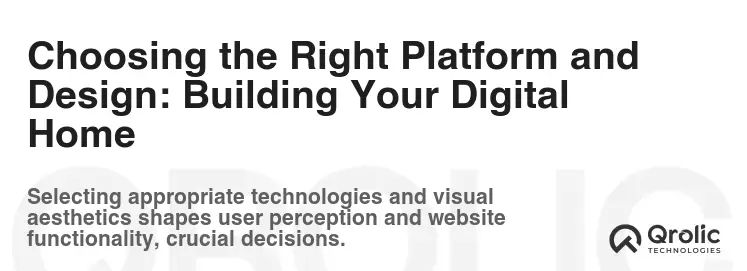
Now that you have a plan for your website’s structure and content, you need to choose the right platform and design. This is where your website starts to take shape and become a tangible representation of your animation studio.
Website Platforms: CMS vs. Custom Development
Content Management System (CMS): A CMS like WordPress, Wix, or Squarespace is a user-friendly platform that allows you to easily create and manage your website’s content.
- Pros: Affordable, easy to use, customizable with themes and plugins, large community support.
- Cons: Limited customization options compared to custom development, potential security vulnerabilities, performance issues with poorly optimized themes and plugins.
- Best For: Most animation studios, especially those with limited budgets or technical expertise.
Custom Development: Custom development involves building your website from scratch using code.
- Pros: Full control over design and functionality, highly scalable, optimized for performance.
- Cons: Expensive, requires technical expertise, time-consuming.
- Best For: Large animation studios with complex requirements and a dedicated development team.
Why wordpress is often the best choice: WordPress offers a great balance of flexibility, affordability, and ease of use. With thousands of themes and plugins available, you can create a custom website that perfectly reflects your brand and meets your specific needs without breaking the bank.
Website Design: Creating a Visually Stunning Experience
- Professional and Modern Design: Your website’s design should be professional, modern, and visually appealing. It should reflect the quality of your animation work and create a positive first impression.
- Mobile-Responsive Design: Your website should be mobile-responsive, meaning it adapts to different screen sizes and devices. This is crucial for providing a good user experience on smartphones and tablets.
- Brand Consistency: Your website’s design should be consistent with your brand identity, including your logo, colors, fonts, and overall style.
- User-Friendly Navigation: Your website’s navigation should be clear and intuitive, making it easy for visitors to find what they’re looking for.
- Fast Loading Speed: Your website should load quickly to avoid frustrating visitors and negatively impacting your search engine ranking. Optimize images, videos, and code to improve loading speed.
Essential Design Elements for Animation Studio Websites:
- Large, High-Quality Visuals: Showcase your best animation work prominently using large, high-quality images and videos.
- Animation and Motion: Incorporate subtle animations and motion effects to add visual interest and engagement.
- Clean and Minimalist Design: Avoid clutter and distractions. Use a clean and minimalist design to focus attention on your animation work.
- Bold Typography: Use bold and eye-catching typography to create a strong visual hierarchy and highlight important information.
- Interactive Elements: Incorporate interactive elements such as animations, quizzes, or interactive portfolios to engage visitors and encourage them to explore your website.
SEO Optimization: Getting Your Website Seen
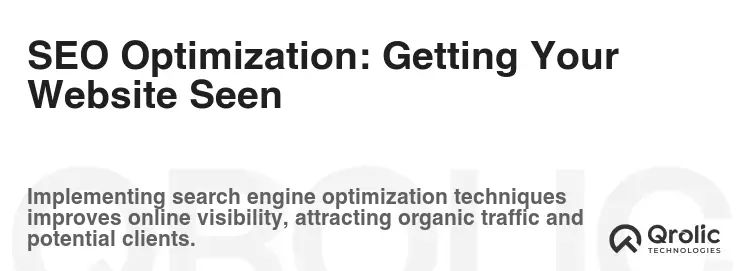
Creating a beautiful and functional website is only half the battle. You also need to optimize it for search engines so that potential clients can find you online.
Keyword Research: Finding the Right Terms
- Identify Relevant Keywords: Use keyword research tools like Google Keyword Planner, SEMrush, or Ahrefs to identify the keywords that your target audience is using to search for animation services.
- Long-Tail Keywords: Focus on long-tail keywords, which are longer and more specific phrases. These keywords are less competitive and can attract highly qualified traffic.
- Example: Instead of targeting the keyword “animation,” target “3D animation for medical device marketing.”
- Competitor Analysis: Analyze your competitors’ websites to see what keywords they are targeting.
On-Page Optimization: Making Your Website Search Engine Friendly
- Title Tags: Optimize your title tags to include relevant keywords. The title tag is the first thing that search engines and users see, so it’s important to make it compelling and informative.
- Meta Descriptions: Write compelling meta descriptions that entice users to click on your website in search results.
- Header Tags: Use header tags (H1, H2, H3, etc.) to structure your content and highlight important keywords.
- Image Alt Text: Add descriptive alt text to your images to help search engines understand what the images are about.
- Content Optimization: Write high-quality, original content that is relevant to your target audience and includes your target keywords.
- Internal Linking: Link to other relevant pages on your website to improve navigation and distribute link juice.
Off-Page Optimization: Building Your Website’s Authority
- Link Building: Earn high-quality backlinks from other websites to increase your website’s authority and search engine ranking.
- Guest Blogging: Write guest posts for other websites in your industry and include a link back to your website.
- Directory Submissions: Submit your website to relevant online directories.
- Social Media Promotion: Promote your website on social media to increase its visibility.
- Social Media Marketing: Build a strong social media presence to engage with your target audience and drive traffic to your website.
- Online Reputation Management: Monitor your online reputation and respond to reviews and comments to build trust and credibility.
Technical SEO: Ensuring Your Website is Crawlable
- Website Speed Optimization: Ensure your website loads quickly to improve user experience and search engine ranking.
- Mobile-Friendliness: Ensure your website is mobile-friendly to provide a good user experience on smartphones and tablets.
- XML Sitemap: Create an XML sitemap to help search engines crawl and index your website.
- Robots.txt File: Use a robots.txt file to control which pages search engines can crawl.
- HTTPS Security: Ensure your website is secured with HTTPS to protect user data and improve search engine ranking.
Promoting Your Website: Getting the Word Out

Once your website is live, you need to promote it to attract traffic and generate leads.
Social Media Marketing: Engaging Your Audience
- Choose the Right Platforms: Focus on the social media platforms that your target audience uses.
- Create Engaging Content: Share your animation work, behind-the-scenes content, and industry insights.
- Engage with Your Audience: Respond to comments and messages, and participate in relevant conversations.
- Run Contests and Giveaways: Attract new followers and generate leads by running contests and giveaways.
- Use Social Media Advertising: Target specific demographics and interests to reach your ideal clients.
Email Marketing: Nurturing Leads and Building Relationships
- Build an Email List: Offer a free resource or incentive to encourage visitors to sign up for your email list.
- Segment Your List: Segment your email list based on demographics, interests, and behavior to send targeted emails.
- Send Valuable Content: Share your animation work, industry insights, and company news.
- Promote Your Services: Highlight your services and offer special promotions to your email subscribers.
- Track Your Results: Track your email open rates, click-through rates, and conversion rates to optimize your email marketing campaigns.
Content Marketing: Providing Value and Building Authority
- Create a Blog: Share your expertise, industry insights, and company news.
- Create Case Studies: Showcase successful projects and demonstrate your expertise.
- Create Infographics: Visualize data and information in an engaging and shareable format.
- Create Videos: Share your animation work, behind-the-scenes content, and tutorials.
- Promote Your Content: Share your content on social media, email, and other channels.
Paid Advertising: Reaching a Wider Audience
- Google Ads: Use Google Ads to target specific keywords and demographics and drive traffic to your website.
- Social Media Advertising: Use social media advertising to target specific demographics and interests and reach your ideal clients.
- Retargeting Ads: Use retargeting ads to reach visitors who have previously visited your website but haven’t yet converted.
Analyzing and Improving: Continuous Optimization

Creating an animation studio website is not a one-time project. It’s an ongoing process of analysis, improvement, and optimization.
Website Analytics: Tracking Your Progress
- Google Analytics: Use Google Analytics to track your website’s traffic, engagement, and conversion rates.
- Website Heatmaps: Use website heatmaps to see how visitors are interacting with your website.
- A/B Testing: Use A/B testing to test different versions of your website and optimize for conversions.
Identifying Areas for Improvement:
- Low Traffic Pages: Identify pages with low traffic and optimize them for search engines or improve their content.
- High Bounce Rate Pages: Identify pages with a high bounce rate and improve their design, content, and user experience.
- Low Conversion Rate Pages: Identify pages with a low conversion rate and optimize them for conversions.
Implementing Changes and Monitoring Results:
- Prioritize Changes: Focus on the changes that are likely to have the biggest impact on your website’s performance.
- Implement Changes Carefully: Test changes thoroughly before implementing them on your live website.
- Monitor Results: Track the results of your changes and make adjustments as needed.
Qrolic Technologies: Your Partner in Digital Success

At Qrolic Technologies (https://qrolic.com/), we understand the unique challenges and opportunities that animation studios face in the digital landscape. We offer a range of services to help you create a website that not only showcases your creative talent but also drives business growth.
How Qrolic Technologies Can Help Your Animation Studio:
- Website Design and Development: We create custom websites that are visually stunning, user-friendly, and optimized for search engines.
- SEO Optimization: We help you improve your website’s search engine ranking and attract more organic traffic.
- Content Marketing: We create high-quality content that engages your audience and positions you as a thought leader in the animation industry.
- Social Media Marketing: We help you build a strong social media presence and connect with your target audience.
- Paid Advertising: We create and manage paid advertising campaigns that drive traffic and generate leads.
We are committed to helping animation studios like yours succeed online. Contact us today to learn more about how we can help you create a website that achieves your business goals.
Final Thoughts: Your Animation Studio Website is an Investment
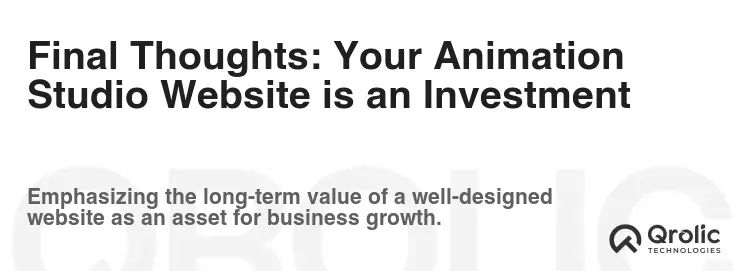
Creating a successful animation studio website requires careful planning, execution, and ongoing optimization. It’s an investment in your brand, your reputation, and your future. By following the steps outlined in this guide, you can create a website that attracts clients, showcases your talent, and drives business growth. Remember to stay updated with the latest trends and technologies in web design and SEO to ensure your website remains competitive and effective. Good luck!
